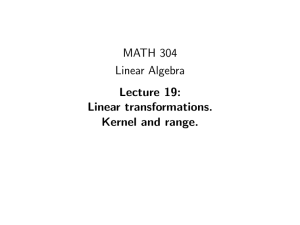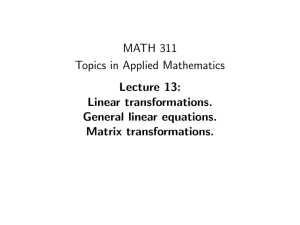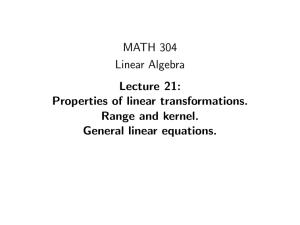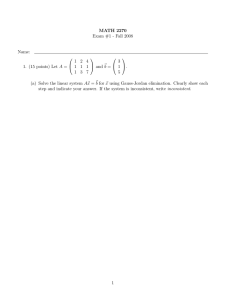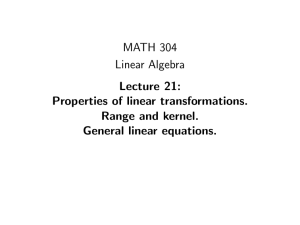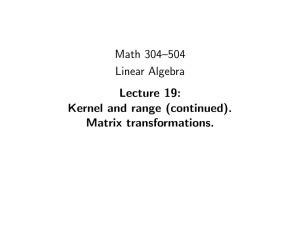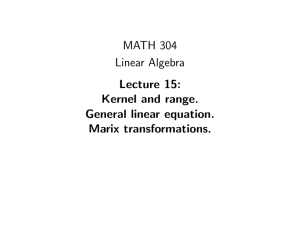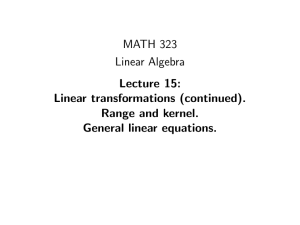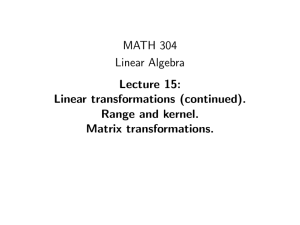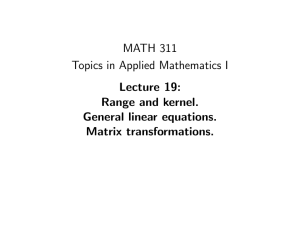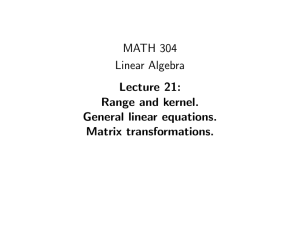MATH 304 Linear Algebra Lecture 20: Linear transformations.
advertisement
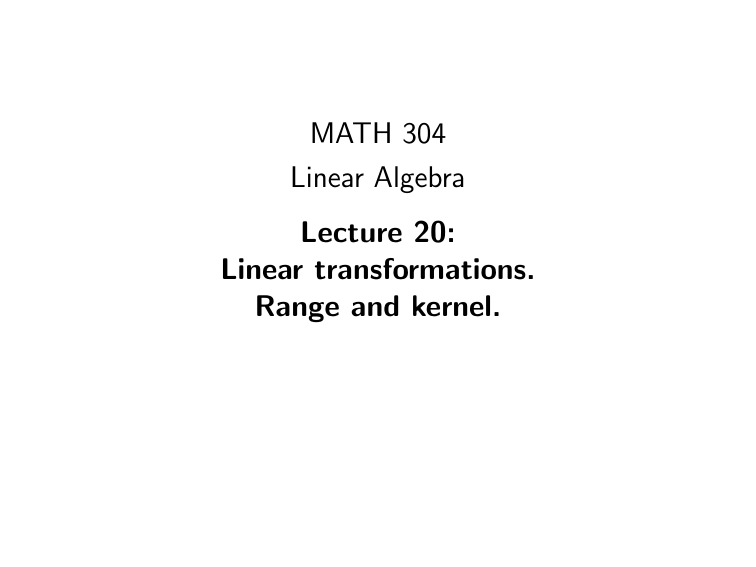
MATH 304 Linear Algebra Lecture 20: Linear transformations. Range and kernel. Linear mapping = linear transformation = linear function Definition. Given vector spaces V1 and V2 , a mapping L : V1 → V2 is linear if L(x + y) = L(x) + L(y), L(r x) = rL(x) for any x, y ∈ V1 and r ∈ R. A linear mapping ℓ : V → R is called a linear functional on V . If V1 = V2 (or if both V1 and V2 are functional spaces) then a linear mapping L : V1 → V2 is called a linear operator. Linear mapping = linear transformation = linear function Definition. Given vector spaces V1 and V2 , a mapping L : V1 → V2 is linear if L(x + y) = L(x) + L(y), L(r x) = rL(x) for any x, y ∈ V1 and r ∈ R. Remark. A function f : R → R given by f (x) = ax + b is a linear transformation of the vector space R if and only if b = 0. Properties of linear mappings Let L : V1 → V2 be a linear mapping. • L(r1 v1 + · · · + rk vk ) = r1 L(v1 ) + · · · + rk L(vk ) for all k ≥ 1, v1 , . . . , vk ∈ V1 , and r1 , . . . , rk ∈ R. L(r1 v1 + r2 v2 ) = L(r1 v1 ) + L(r2 v2 ) = r1 L(v1 ) + r2 L(v2 ), L(r1 v1 + r2 v2 + r3 v3 ) = L(r1 v1 + r2 v2 ) + L(r3 v3 ) = = r1 L(v1 ) + r2 L(v2 ) + r3 L(v3 ), and so on. • L(01 ) = 02 , where 01 and 02 are zero vectors in V1 and V2 , respectively. L(01 ) = L(001 ) = 0L(01 ) = 02 . • L(−v) = −L(v) for any v ∈ V1 . L(−v) = L((−1)v) = (−1)L(v) = −L(v). Examples of linear mappings • Scaling L : V → V , L(v) = sv, where s ∈ R. L(x + y) = s(x + y) = sx + sy = L(x) + L(y), L(r x) = s(r x) = r (sx) = rL(x). • Dot product with a fixed vector ℓ : Rn → R, ℓ(v) = v · v0 , where v0 ∈ Rn . ℓ(x + y) = (x + y) · v0 = x · v0 + y · v0 = ℓ(x) + ℓ(y), ℓ(r x) = (r x) · v0 = r (x · v0 ) = r ℓ(x). • Cross product with a fixed vector L : R3 → R3 , L(v) = v × v0 , where v0 ∈ R3 . • Multiplication by a fixed matrix L : Rn → Rm , L(v) = Av, where A is an m×n matrix and all vectors are column vectors. Linear mappings of functional vector spaces • Evaluation at a fixed point ℓ : F (R) → R, ℓ(f ) = f (a), where a ∈ R. • Multiplication by a fixed function L : F (R) → F (R), L(f ) = gf , where g ∈ F (R). • Differentiation D : C 1 (R) → C (R), L(f ) = f ′ . D(f + g ) = (f + g )′ = f ′ + g ′ = D(f ) + D(g ), D(rf ) = (rf )′ = rf ′ = rD(f ). • Integration over a finite Z b interval f (x) dx, where ℓ : C (R) → R, ℓ(f ) = a a, b ∈ R, a < b. Properties of linear mappings • If a linear mapping L : V → W is invertible then the inverse mapping L−1 : W → V is also linear. • If L : V → W and M : W → X are linear mappings then the composition M ◦ L : V → X is also linear. • If L1 : V → W and L2 : V → W are linear mappings then the sum L1 + L2 is also linear. Linear differential operators • an ordinary differential operator d2 d ∞ ∞ L : C (R) → C (R), L = g0 2 + g1 + g2 , dx dx where g0 , g1 , g2 are smooth functions on R. That is, L(f ) = g0 f ′′ + g1 f ′ + g2 f . • Laplace’s operator ∆ : C ∞ (R2 ) → C ∞ (R2 ), ∂ 2f ∂ 2f ∆f = 2 + 2 ∂x ∂y (a.k.a. the Laplacian; also denoted by ∇2 ). Range and kernel Let V , W be vector spaces and L : V → W be a linear mapping. Definition. The range (or image) of L is the set of all vectors w ∈ W such that w = L(v) for some v ∈ V . The range of L is denoted L(V ). The kernel of L, denoted ker L, is the set of all vectors v ∈ V such that L(v) = 0. Theorem (i) The range of L is a subspace of W . (ii) The kernel of L is a subspace of V . x 1 0 −1 x 3 3 y . Example. L : R → R , L y = 1 2 −1 z 1 0 −1 z The kernel ker L is the nullspace of the matrix. x 1 0 −1 L y = x 1 + y 2 + z −1 z 1 0 −1 The range f (R3 ) is the column space of the matrix. x 1 0 −1 x 3 3 Example. L : R → R , L y = 1 2 −1 y . z 1 0 −1 z The range of L is spanned by vectors (1, 1, 1), (0, 2, 0), and (−1, −1, −1). It follows that L(R3 ) is the plane spanned by (1, 1, 1) and (0, 1, 0). To find 1 0 1 2 1 0 ker L, we apply row reduction to 1 1 0 −1 −1 0 → 0 −1 → 0 2 0 0 0 0 −1 the matrix: 0 −1 1 0 0 0 Hence (x, y , z) ∈ ker L if x − z = y = 0. It follows that ker L is the line spanned by (1, 0, 1). More examples f : M2 (R) → M2 (R), f (A) = A + AT . a b 2a b + c f = . c d b + c 2d ker f is the subspace of anti-symmetric matrices, the range of f is the subspace of symmetric matrices. 0 1 A. g : M2 (R) → M2 (R), g (A) = 0 0 a b c d = . g c d 0 0 The range of g is the subspace of matrices with the zero second row, ker g is the same as the range =⇒ g (g (A)) = O. P: the space of polynomials. Pn : the space of polynomials of degree less than n. D : P → P, (Dp)(x) = p ′ (x). p(x) = a0 + a1 x + a2 x 2 + a3 x 3 + · · · + an x n =⇒ (Dp)(x) = a1 + 2a2 x + 3a3 x 2 + · · · + nan x n−1 The range of D is the entire P, ker D = P1 = the subspace of constants. D : P4 → P4 , (Dp)(x) = p ′ (x). p(x) = ax 3 +bx 2 +cx+d =⇒ (Dp)(x) = 3ax 2 +2bx+c The range of D is P3 , ker D = P1 .
